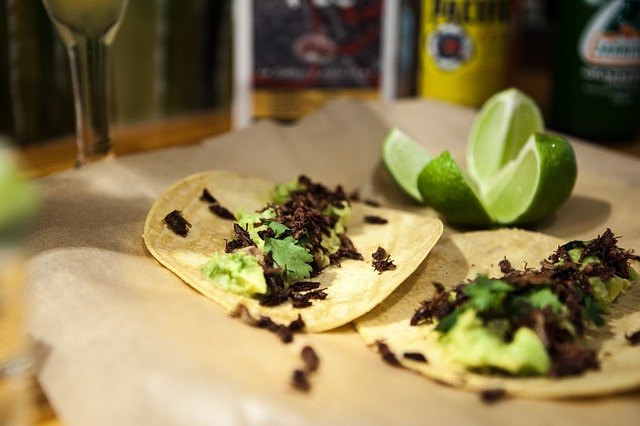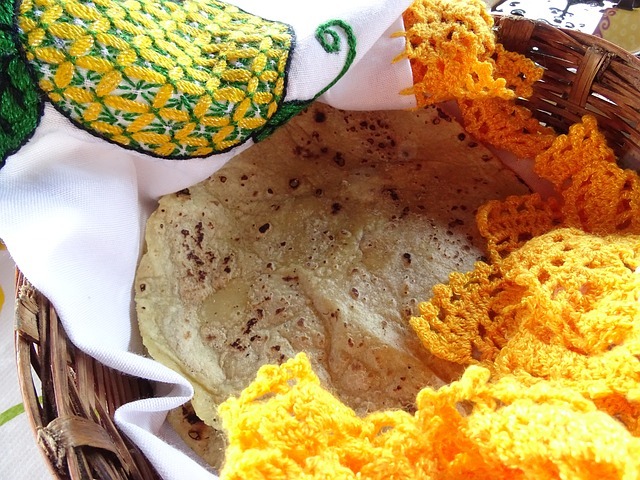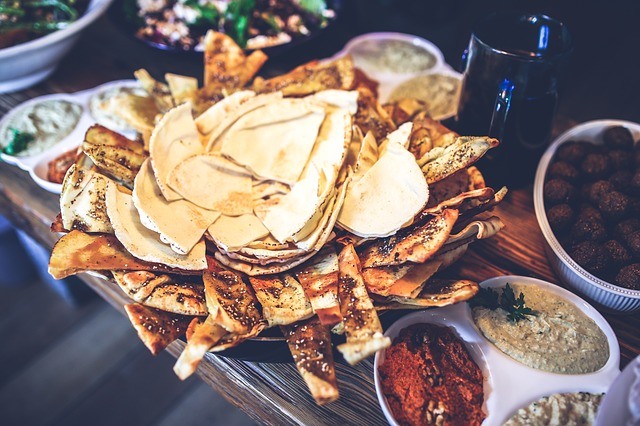Unleavened bread comes in many shapes, sizes, and flavors. Googling the topic will give you more recipes than you know what to do with, but most people eat unleavened bread all the time without much thought.
From tortillas, to crepes, to roti, to matzo (primarily eaten for Jewish Passover), there is a form of unleavened bread from almost every major culture around the world. Tortillas are probably the most commonly eaten form, especially in the United States, Mexico, and Central America.

There are two types of tortillas: flour and corn. They differ in the types of dry ingredients used to make them.
Corn tortillas are usually made with masa harina which is a traditional flour used to make tamales as well as tortillas and other Mexican dishes.
The term translates from Spanish to English as dough flour. The flour is made from dried masa which is made of hominy, or dried corn kernels that have been cooked and soaked in lime water.
Flour tortillas, on the other hand, are made using regular all-purpose wheat flour. Now, of course you can buy both kinds of tortillas at your local grocery store, but where is the fun in that?
Here are two recipes to help you achieve warm, fresh tortillas in your own home.
Contents
How to Make Unleavened Bread
Flour Tortilla Unleavened Bread Recipe
Serves 16
Ingredients
- 3 cups all-purpose flour
- 1 teaspoon salt
- 1 teaspoon baking powder
- ⅓ cup vegetable oil
- 1 cup warm water
Instructions
- Combine flour, salt, and baking powder in the bowl. If using a stand mixer, use the dough hook. Mix dry ingredients until well combined.
- Add oil and water with mixer running at a medium speed. Mix for 1 minute, stopping several times to scrape the sides of the bowl. After about 1 minute, or when mixture comes together to form a ball, decrease mixing speed to low. Continue to mix for 1 minute or until dough is smooth.
- Transfer from mixing bowl to a well-floured surface. Divide into 16 equal portions. Turn each piece to coat with flour. Flatten each ball with the palm of your hand. Cover flattened balls of dough with a clean kitchen towel and allow to rest for 15 minutes.
- After rest period, heat a large pan over medium-high heat. Roll out each flattened dough piece into a rough circle, about 6-7 inches in diameter. Keep work surface and rolling pin lightly floured. Don’t stack uncooked tortillas on top of each other or they will become soggy.
- When pan is hot, place one dough circle into pan and allow to cook about 1 minute or until bottom surface has a few pale brown spots. The uncooked surface will begin to show a few bubbles. Flip to other side and cook for about 30 seconds. The tortilla should be soft but have a few pale golden-brown spots on the surface. Remove from pan with tongs and stack in a covered container or zip-top bag until all tortillas are cooked. Wipe out the pan in between tortillas if flour is starting to collect.
- Serve warm or allow to cool for later use. When ready to use, place a slightly damp paper towel in the bottom of a microwave-safe container. Microwave, uncovered, for 15-25 seconds or until warm, then cover to hold heat while serving.
- Store in an airtight container or plastic zip-top bag at room temperature for up to 24 hours. Refrigerate for up to 1 week in zip-top bag or freeze indefinitely. To freeze, separate tortillas with parchment or waxed paper and place in a zippered bag before placing in freezer.

Flour Tortillas in a Bread Machine
Recipe for a bread machine: You need 2 cups bread flour, 1/2 teaspoon salt, 3 tablespoons shortening, and 1/2 cup water.
Place all ingredients in your machine’s pan, in the order specified by your machine’s manual.
Select the dough cycle and press start. The dough should form a nice round ball. You may need to add a tablespoon of water or flour.
When the dough cycle is finished kneading, stop the machine and remove the dough to a lightly floured surface.
Divide the dough in to equal size portions and then follow the above recipe from there.
Corn Tortilla Unleavened Bread Recipe
Makes about 20 6-inch tortillas
Ingredients
- 2 cups masa harina
- 1/2 teaspoon kosher salt
- 1 1/2 cups hot water
Instructions
- Cut a zip-top bag open along the sides. Open the tortilla press and lay the opened bag on top. (The plastic can be reused indefinitely; just wipe it clean after each use.)
- Mix the masa harina and salt together in a mixing bowl. Pour in water. Stir to combine.
- Using hands, knead dough for 1-2 minutes in the bowl. The dough is ready when smooth but no longer sticky. It should easily form a ball in your hand.
- If the dough absorbs all the water but is still crumbly, add water a tablespoon at a time. If the dough feels sticky, add more masa harina a tablespoon at a time.
- If you have the time, cover the bowl with a towel and rest dough for 15 – 30 minutes. This gives the masa harina time to fully absorb the water and improves the taste and texture of the tortillas.
- Pinch off a few tablespoons of dough and roll it between your hands to form a ball roughly the size of a ping-pong ball. This will make about a 6-inch tortilla. Adjust the amount of dough if needed.
- Place the ball of dough in the middle of the plastic-covered tortilla press. Fold the other side of the plastic bag over the top of the dough. Bring the top of the press down over the dough, and press the handle to flatten the dough to about 1/8-inch thick. If the tortilla doesn’t look quite even after pressing or you’d like it thinner, rotate the tortilla in the plastic and re-press.
- Peel away the top of the plastic, flip the tortilla over, and peel off the plastic from the back.
- You can cook the tortillas as you press them or you can press out all the tortillas and then cook them. Keep both the dough and the stack of pressed tortillas covered with clean towels. If you choose to press all the tortillas and then cook them, be careful when peeling each tortilla off the stack. They may stick to each other or break around the edges.
- Warm a large, flat cast iron griddle or skillet over medium-high heat. When ready, flick a few drops of water onto the surface. They should sizzle immediately.
- Gently position as many tortillas in the pan as will fit in a single layer without overlapping. Cook for 1- 2 minutes until the edges are starting to curl up and the bottoms look dry and pebbly. Flip and cook another 1- 2 minutes on the other side. When done, both sides should be dry to the touch and beginning to show some brown spots.
- As you take cooked tortillas off the griddle, stack them up and wrap them in a clean kitchen towel. The tortillas will continue to steam and soften inside the towel as you finish cooking the rest.
- Fresh corn tortillas are best still warm, but leftover tortillas are also quite good. Let any leftovers cool completely still wrapped in a towel, put them in an airtight container or zip-top bag and refrigerate for up to three days.
- To reheat the tortillas, dampen a kitchen towel or paper towel slightly and wrap the tortillas loosely. Microwave in 30-second bursts until the tortillas are warm and pliable. Eat immediately.
 You can also use a rolling pin to flatten the tortillas, if you don’t have a press. It is more difficult to make them perfectly round but still works just fine. Start in the middle and roll out to the edges.
You can also use a rolling pin to flatten the tortillas, if you don’t have a press. It is more difficult to make them perfectly round but still works just fine. Start in the middle and roll out to the edges.
Looking for recipes to make with your tortillas? Watch the video below to see how to make a lasagna out of your unleavened bread.
Conclusion
No matter the kind of unleavened bread you are trying to make, they all tend to have a few things in common.
Most, if not all, contain flour, fat (oil, butter, lard, etc.), water, and salt.
They also almost always involve mixing the dry ingredients together and then pouring or cutting in the liquids or the fat.
Beyond that, the methods of preparing and cooking unleavened breads vary as much as the cultures and people who created them.
Have you tried making your own unleavened bread?
